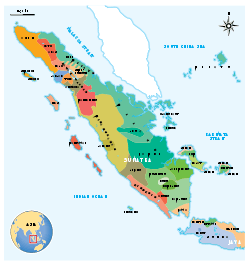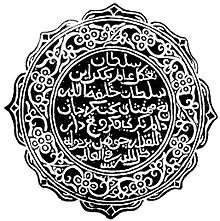Minangkabau language
| Minangkabau | |
|---|---|
|
Baso Minangkabau باسو مينڠكاباو | |
| Native to | Indonesia, Malaysia (Negeri Sembilan) |
| Region | West Sumatra, Riau, Jambi, Bengkulu, North Sumatra, Aceh (Indonesia), Negeri Sembilan (Malaysia) |
| Ethnicity | Minangkabau |
Native speakers |
5.5 million in Indonesia (2007)[1] 901,000 in Malaysia (2016)[2] |
| Dialects |
|
| Official status | |
Official language in |
|
Recognised minority language in | |
| Regulated by | Badan Pengembangan dan Pembinaan Bahasa |
| Language codes | |
| ISO 639-2 |
min |
| ISO 639-3 |
Either:min – Minangkabauzmi – Negeri Sembilan Malay |
| Glottolog |
mina1268 Minangkabau[3]nege1240 Negeri Sembilan Malay[4] |
 Map of Minangkabau language in Sumatra is shown by light and dark olive | |
Minangkabau (autonym: Baso Minang(kabau); Indonesian: Bahasa Minangkabau) is an Austronesian language spoken by the Minangkabau of West Sumatra, the western part of Riau, South Aceh Regency, the northern part of Bengkulu and Jambi, also in several cities throughout Indonesia by migrated Minangkabau.[5] The language is also a lingua franca along the western coastal region of the province of North Sumatra, and is even used in parts of Aceh, where the language is called Aneuk Jamee. It is also spoken in some parts of Malaysia, especially Negeri Sembilan.
Due to the huge proximity between the Minangkabau language and Malay, there is some controversy regarding the relationship between the two. Some see Minangkabau as a nonstandardized dialect of Malay, while others think of Minangkabau as a proper (Malay) language.

Malaysia
Besides Indonesia, Minangkabau is also spoken in Malaysia, by some descendants of migrants from the Minang-speaking region in Sumatra (Ranah Minang, Tanah Minang, or Land of the Minang). Significant numbers of the early migrants settled in what is now the Malaysian state of Negeri Sembilan; this Negeri Sembilan Malay is known as Bahaso Nogori / Baso Nogoghi. More recent immigrants are known as Minang.
Dialects
The Minangkabau language has several dialects, sometimes differing between nearby villages (e.g. separated by a river). The dialects are Rao Mapat Tunggul, Muaro Sungai Lolo, Payakumbuh, Pangkalan-Lubuk Alai, Agam-Tanah Datar, Pancungsoal, Kotobaru, Sungai Bendung Air, and Karanganyar.[6] In everyday communication between Minangkabau people of different regions, the Agam-Tanah Datar dialect (Baso Padang or Baso Urang Awak "our (people's) language") is often used and has become a kind of standard.
The Tapan language, spoken in the town of Tapan in southern West Sumatra province, is a recently discovered Malayan language which has been proposed as related to but not part of Minangkabau. Together, Tapan and Minangkabau would form a Greater Minangkabau subgroup.[7] The two languages Tapan and Muko-Muko form a Lunangic subgroup within the Minangic (Greater Minangkabau) language group.[8][9]
The Minangic subgroup is characterized by the following word-final sound changes.[10]
- *V[hi]ŋ > V[hi]ăŋ
- *us > uĭh
- *at > eʔ
- *as > eh
- *is > ih
Vowels and consonants
The phonology and orthography of Minangkabau is listed below[11]:
| Labial | Alveolar | Palatal | Velar | Glottal | ||
|---|---|---|---|---|---|---|
| Plosive | voiceless | p [p] | t [t] | k [k] | q [ʔ] | |
| voiced | b [b] | d [d] | g [ɡ] | |||
| Fricative | s [s] | h [h] | ||||
| Affricate | voiceless | c [tʃ] | ||||
| voiced | j [dʒ] | |||||
| Nasal | m [m] | n [n] | ny [ɲ] | ng [ŋ] | ||
| Lateral | l [l] | |||||
| Rhotic | r [r] | |||||
| Approximant | w [w] | y [j] | ||||
| Front | Central | Back | |
|---|---|---|---|
| Close | i [i] | u [u] | |
| Mid | e [e] | ē [ə] | o [o] |
| Open | a [a] |
Example
Sentences
| English | Minangkabau | Indonesian/Malay |
|---|---|---|
| How are you now? | Ba'a kaba sanak kini? | Bagaimana kabar anda sekarang? |
| I'm well. How about you? | Lai elok-elok se nyo. Sanak ba'a? | Saya baik-baik saja. Anda bagaimana? |
| What is your name? | Sia namo sanak? | Siapa nama anda? |
| My name is ... | Namo ambo ... | Nama saya ... |
| Thank you. | Tarimo kasih. | Terima kasih. |
| The trees in the jungle don't have the same height, moreover the people. (Proverb) | Sadang kayu di rimbo 'ndak samo tinggi, apo lai manusia. (Pribaso) | Sedangkan pohon di hutan tidak sama tinggi, apalagi manusia. (Peribahasa) |
| "As the frog swims, so he/she swims too." (He/she is doing something without having a goal.) | "Co a koncek baranang co itu inyo" ba'arti mangarajokan suatu tapi indak punyo tujuan. | "Bagaimana katak berenang seperti itulah dia" berarti mengerjakan sesuatu tanpa punya tujuan. |
| Don't throw the rubbish here! (Command) | Indak Buliah mambuang sarok di siko! (Parintah) | Dilarang membuang sampah di sini! (Perintah) |
| Do not touch! You will burn your hand. | Ijan dipacik! Beko tangan angku tabaka. | Jangan disentuh! Nanti tanganmu terbakar. |
Numbers
| Number | Minangkabau | Indonesian/Malay | English |
|---|---|---|---|
| 1 | cie' | satu | one |
| 2 | duo | dua | two |
| 3 | tigo | tiga | three |
| 4 | ampe' | empat | four |
| 5 | limo | lima | five |
| 6 | anam | enam | six |
| 7 | tujuah | tujuh | seven |
| 8 | lapan | delapan | eight |
| 9 | sambilan | sembilan | nine |
| 10 | sapuluah | sepuluh | ten |
| 11 | sabaleh | sebelas | eleven |
| 15 | limo baleh | lima belas | fifteen |
| 50 | limo puluah | lima puluh | fifty |
| 100 | saratuih | seratus | one hundred/a hundred |
| 150 | saratuih limo puluah | seratus lima puluh | one hundred and fifty |
| 500 | limo ratuih | lima ratus | five hundred |
| #,000 | ribu | ribu | thousand |
| #,000,000 | juta | juta | million |
| #,000,000,000 | millia | milliar | billion |
See also
| Minangkabau edition of Wikipedia, the free encyclopedia |
References
- ↑ Minangkabau at Ethnologue (18th ed., 2015)
Negeri Sembilan Malay at Ethnologue (18th ed., 2015) - ↑ Joshua Project. "People Groups". joshuaproject.net. Retrieved 2 July 2015.
- ↑ Hammarström, Harald; Forkel, Robert; Haspelmath, Martin, eds. (2017). "Minangkabau". Glottolog 3.0. Jena, Germany: Max Planck Institute for the Science of Human History.
- ↑ Hammarström, Harald; Forkel, Robert; Haspelmath, Martin, eds. (2017). "Negeri Sembilan Malay". Glottolog 3.0. Jena, Germany: Max Planck Institute for the Science of Human History.
- ↑ Kajian Serba Linguistik : Untuk Anton Moeliono Pereksa Bahasa (2000)
- ↑ Nadra, Reniwati, and Efri Yades, Daerah Asal dan Arah Migrasi Orang Minangkabau di Provinsi Jambi Berdasarkan Kajian Variasi Dialektikal (2008)
- ↑ Santi Kurniati, Yessy Prima Putri, Søren Wichmann and David Gil (2011)." Tapan: An Exploration in Malayic Subgrouping". ISMIL 15 conference presentation. Archived 2011-08-07 at the Wayback Machine.
- ↑ http://ical13.ling.sinica.edu.tw/Full_papers_and_ppts/July_18/G-32.pdf
- ↑ "Archived copy" (PDF). Archived from the original (PDF) on 2015-07-22. Retrieved 2015-07-18.
- ↑ http://ical13.ling.sinica.edu.tw/Full_papers_and_ppts/July_18/G-32.pdf
- ↑ Maksan. 1984, p. 23-24
Further reading
- Nurlela Adnan, Ermitati, Rosnida M. Nur, Pusat Bahasa (Indonesia), Balai Pustaka (Persero), PT. 2001 - Indonesian-Minangkabau dictionary (Kamus bahasa Indonesia-Minangkabau), 841 pages.
- Tata Bahasa Minangkabau, Gerard Moussay (original title La Langue Minangkabau, translated from French by Rahayu S. Hidayat), ISBN 979-9023-16-5.